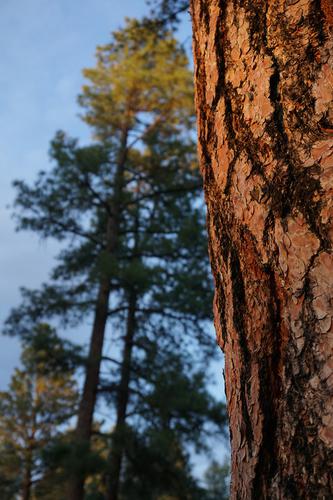Our official English website, www.x-mol.net, welcomes your
feedback! (Note: you will need to create a separate account there.)
A trait‐based approach to assessing resistance and resilience to wildfire in two iconic North American conifers
Journal of Ecology ( IF 5.3 ) Pub Date : 2020-07-27 , DOI: 10.1111/1365-2745.13480 Kyle C. Rodman 1 , Thomas T. Veblen 1 , Robert A. Andrus 1 , Neal J. Enright 2 , Joseph B. Fontaine 2 , Angela D. Gonzalez 1 , Miranda D. Redmond 3 , Andreas P. Wion 3
中文翻译:

一种基于特征的方法来评估北美两个标志性针叶树对野火的抵抗力和复原力
更新日期:2020-07-27
Journal of Ecology ( IF 5.3 ) Pub Date : 2020-07-27 , DOI: 10.1111/1365-2745.13480 Kyle C. Rodman 1 , Thomas T. Veblen 1 , Robert A. Andrus 1 , Neal J. Enright 2 , Joseph B. Fontaine 2 , Angela D. Gonzalez 1 , Miranda D. Redmond 3 , Andreas P. Wion 3
Affiliation

|
- Ongoing changes in fire regimes have the potential to drive widespread shifts in Earth's vegetation. Plant traits and vital rates provide insight into vulnerability to fire‐driven vegetation shifts because they can be indicators of the ability of individuals to survive fire (resistance) and populations to persist (resilience) following fire.
- In 15 study sites spanning climatic gradients in the southern Rocky Mountains, USA, we quantified variation in key traits and vital rates of two co‐occurring, widely distributed conifers (Pinus ponderosa Douglas ex. P. Lawson & C. Lawson and Pseudotsuga menziesii (Mirb.) Franco). We used mixed‐effects models to explain inter‐ and intraspecific variation in tree growth, survival, bark thickness and seed cone production, as a function of species, tree life stage (i.e. diameter, height and age), average climate, local competition and site conditions.
- Pinus ponderosa was predicted to survive low‐severity fire at a 23% earlier age than P. menziesii. Pinus ponderosa had thicker bark and more rapid juvenile height growth, traits conferring greater fire resistance. In contrast, P. menziesii was predicted to produce seed cones at a 28% earlier age than P. ponderosa. For both species, larger individuals were more likely to survive fire and to produce cones. For P. ponderosa, cone production increased where average actual evapotranspiration (AET) was higher and local competition was lower. More frequent cone production on productive sites with higher AET is an important and underappreciated mechanism that may help to explain greater resilience to fire in these areas.
- Synthesis. Our analyses indicated that many plant traits and vital rates related to fire differed between Pinus ponderosa and Pseudotsuga menziesii, with trade‐offs between investment in traits that promote individual defence to fire and those that promote recolonization of disturbed sites. Future changes in fire regimes will act as a filter throughout North American forests, with our findings helping to infer which individuals and populations of two iconic species are most vulnerable to future change and offering a framework for future inquiry in other forests facing an uncertain future.
中文翻译:

一种基于特征的方法来评估北美两个标志性针叶树对野火的抵抗力和复原力
- 持续不断的火势变化有可能推动地球植被的广泛变化。植物性状和生命率可以洞悉火灾引起的植被转移的脆弱性,因为它们可以指示个体在火灾后的生存能力(抵抗力)和种群在火灾后的持久能力(抵抗力)。
- 在美国落基山脉南部15个跨气候梯度的研究地点中,我们量化了两个同时出现的,分布广泛的针叶树(Pinus暂定的针叶树Douglas ex.P.Lawson和C.Lawson和Pseudotsuga menziesii( Mirb。)Franco)。我们使用混合效应模型来解释树种,树种存活,树皮厚度和种锥产量之间的种间和种内变化,这些变化是物种,树的生命阶段(即直径,高度和年龄),平均气候,局部竞争和现场条件。
- 据预测,美国黄松比小孟子更早存活23%。美国黄松的树皮较厚,幼虫的身高增长较快,其性状具有较高的耐火性。与此相反,P.花旗松被预测为在比早先28%年龄产生球果西黄松。对于这两个物种,较大的个体更有可能存活下来并产生圆锥体。对于黄杨,在平均实际蒸散量(AET)较高且本地竞争较低的地方,视锥细胞产量增加。在具有较高AET的生产地点更频繁地生产锥体,这是一个重要且未被重视的机制,可能有助于解释这些地区更大的防火能力。
- 综合。我们的分析表明,黄松和假单胞菌之间的许多与火有关的植物性状和生命率存在差异,需要在促进个体防御火力和促进受干扰地区重新定殖的性状之间进行权衡。未来火灾情况的变化将对整个北美森林起到过滤作用,我们的发现有助于推断两种标志性物种的哪些个人和种群最容易受到未来变化的影响,并为面临不确定未来的其他森林提供了未来调查的框架。











































 京公网安备 11010802027423号
京公网安备 11010802027423号